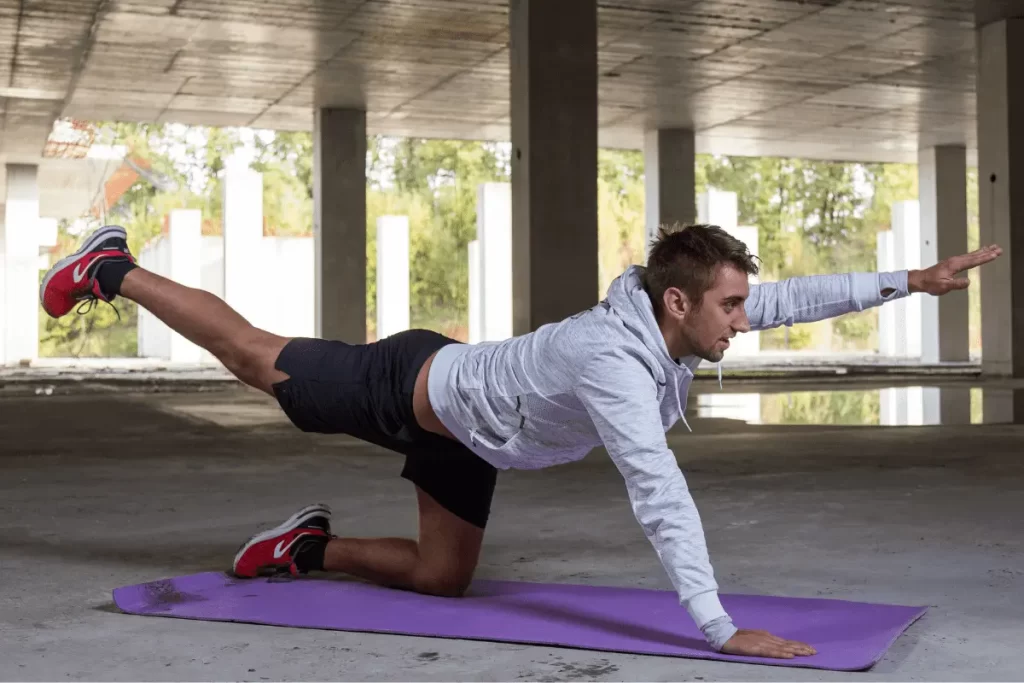Effective Home Exercises for Lower Back Pain: Relieve Discomfort Naturally

Are you tired of dealing with persistent lower back pain? You’re not alone. Lower back pain affects millions of people worldwide, hindering their daily activities and diminishing their quality of life. The good news is that there are effective home exercises you can incorporate into your routine to alleviate discomfort and strengthen your lower back muscles. In this blog post, we will explore various exercises that target the lower back area, promoting relief and overall well-being.
May You Also Like This: Natural Remedies for Migraines: Find Relief Without Medication
Content
Understanding Lower Back Pain

Lower back pain can stem from various causes, such as muscle strain, poor posture, or underlying medical conditions. It can range from mild discomfort to debilitating pain, affecting your ability to perform daily tasks. It’s essential to address the root cause of your pain, but incorporating regular exercise can help manage and prevent future episodes.
Benefits of Exercise for Lower Back Pain
Engaging in targeted exercises for your lower back offers several benefits. Not only do they help relieve pain and stiffness, but they also enhance flexibility, strengthen core muscles, improve posture, and increase blood flow to the affected area. By incorporating these exercises into your routine, you can experience long-term relief and improve your overall spinal health.
Warm-up Routine
Before diving into the exercises, it’s crucial to prepare your body with a warm-up routine. This helps increase blood circulation, loosen muscles, and reduce the risk of injury. Spend around five minutes performing light aerobic activities, such as brisk walking or marching in place.
Exercise 1: Cat-Camel Stretch
The Cat-Camel stretch is an excellent exercise for mobilizing the spine and warming up the lower back muscles. Follow these steps to perform the Cat-Camel stretch:
- Start on all fours, with your hands directly below your shoulders and knees aligned with your hips.
- Slowly arch your back upward while tucking your chin towards your chest (Cat position).
- Hold this position for a few seconds.
- Gradually lower your abdomen toward the ground while lifting your head and tailbone (Camel position).
- Repeat the Cat-Camel stretch for 10-12 repetitions, focusing on smooth and controlled movements.
Exercise 2: Bridge Pose
The Bridge pose targets the glutes, hamstrings, and lower back muscles. It helps improve spinal mobility and strengthens the core. Here’s how to perform the Bridge pose:
- Lie flat on your back, with your knees bent and feet hip-width apart, flat on the ground.
- Place your arms alongside your body, palms facing down.
- Engage your core and lift your hips off the ground, creating a straight line from your knees to your shoulders.
- Hold the pose for 15-30 seconds, focusing on maintaining stability and avoiding excessive arching of the back.
- Gently lower your hips back down to the starting position.
- Repeat the Bridge pose for 8-10 repetitions.
Exercise 3: Bird Dog

The Bird Dog exercise strengthens the muscles in your lower back, abdomen, and hips, promoting stability and balance. Follow these steps to perform the Bird Dog exercise:
- Start on all fours, with your hands directly below your shoulders and knees aligned with your hips.
- Extend your right arm forward while simultaneously extending your left leg backward.
- Keep your spine neutral and engage your core to maintain balance.
- Hold this position for a few seconds.
- Return to the starting position and repeat the movement with your left arm and right leg.
- Aim for 10-12 repetitions on each side.
Exercise 4: Pelvic Tilt
The Pelvic Tilt exercise targets the muscles in your lower back and abdomen, helping to alleviate pain and improve posture. Here’s how to perform the Pelvic Tilt:
- Lie flat on your back, with your knees bent and feet hip-width apart, flat on the ground.
- Place your arms alongside your body, palms facing down.
- Slowly tilt your pelvis upward, pressing your lower back against the floor.
- Hold the position for a few seconds.
- Release and return to the starting position.
- Repeat the Pelvic Tilt exercise for 10-12 repetitions.
Exercise 5: Knee-to-Chest Stretch
The Knee-to-Chest stretch stretches the muscles in your lower back and buttocks, providing relief from pain and tension. Follow these steps to perform the Knee-to-Chest stretch:
- Lie flat on your back, with your knees bent and feet flat on the ground.
- Place your hands behind one knee and gently pull it toward your chest.
- Hold the stretch for 20-30 seconds, feeling a gentle pull in your lower back and buttocks.
- Release and repeat the stretch with the opposite leg.
- Perform 2-3 repetitions on each side.
Exercise 6: Child’s Pose
Child’s Pose is a relaxing stretch that targets the muscles in your lower back, hips, and thighs. It helps release tension and promotes relaxation. Here’s how to perform Child’s Pose:
- Start on all fours, with your knees hip-width apart and your toes touching.
- Lower your hips toward your heels and extend your arms forward, resting your forehead on the ground.
- Hold the pose for 30-60 seconds, focusing on deep breathing and allowing your lower back to relax.
- Slowly come out of the pose and return to the starting position.
- Repeat Child’s Pose 2-3 times, or as desired.
Exercise 7: Superman Pose
The Superman Pose strengthens the muscles in your lower back, glutes, and shoulders, promoting stability and posture. Follow these steps to perform the Superman Pose:
- Lie flat on your stomach, with your arms extended forward and legs straight.
- Simultaneously lift your arms, chest, and legs off the ground, keeping your neck neutral.
- Hold the pose for 10-15 seconds, focusing on engaging your lower back muscles.
- Gently lower your arms, chest, and legs back to the ground.
- Repeat the Superman Pose for 8-10 repetitions.
Exercise 8: Pelvic Clock
The Pelvic Clock exercise enhances awareness of pelvic movement and improves lower back mobility. Here’s how to perform the Pelvic Clock exercise:
- Lie flat on your back, with your knees bent and feet flat on the ground.
- Visualize a clock on your pelvis, with the navel as the center.
- Slowly and gently tilt your pelvis forward, backward, and to each side, tracing the numbers on the imaginary clock.
- Perform 5-10 repetitions in each direction, focusing on smooth and controlled movements.
Exercise 9: Cobra Stretch

The Cobra Stretch stretches the muscles in your abdomen, chest, and lower back, promoting flexibility and relieving discomfort. Follow these steps to perform the Cobra Stretch:
- Lie flat on your stomach, with your legs extended and the tops of your feet pressing into the ground.
- Place your hands directly below your shoulders, fingers pointing forward.
- Press your palms into the ground and lift your upper body, keeping your hips and legs grounded.
- Hold the stretch for 15-30 seconds, focusing on breathing deeply and elongating the spine.
- Gently lower your upper body back down to the ground.
- Repeat the Cobra Stretch 2-3 times, or as desired.
Exercise 10: Hamstring Stretch
The Hamstring Stretch targets the muscles in the back of your thighs, releasing tension and improving flexibility. Here’s how to perform the Hamstring Stretch:
- Sit on the edge of a chair or a sturdy surface, with your feet flat on the ground.
- Extend one leg forward, resting your heel on the ground.
- Lean forward from your hips, reaching toward your toes while keeping your back straight.
- Hold the stretch for 20-30 seconds, feeling a gentle pull in the back of your thigh.
- Switch legs and repeat the stretch on the opposite side.
- Perform 2-3 repetitions on each side.
Exercise 11: Plank

The Plank exercise strengthens your core muscles, including the muscles in your lower back. It promotes stability and helps prevent future pain episodes. Follow these steps to perform the Plank:
- Start in a push-up position, with your hands directly below your shoulders and legs extended behind you.
- Engage your core and keep your body in a straight line from head to toe.
- Hold the position for 20-30 seconds, or as long as you can maintain proper form.
- Gradually increase the duration as you build strength.
- Gently lower your knees to the ground and return to the starting position.
- Repeat the Plank exercise for 2-3 sets.
Cooling Down
After completing the exercises, it’s essential to cool down and stretch your muscles. Spend a few minutes performing gentle stretches, such as neck rolls, shoulder rolls, and side bends. This helps prevent muscle soreness and promotes flexibility.
Conclusion
Lower back pain can significantly impact your daily life, but incorporating effective home exercises can provide relief and improve your overall well-being. By targeting the muscles in your lower back, abdomen, and hips, you can alleviate discomfort, strengthen your core, and enhance your posture. Remember to perform these exercises regularly, with proper form and gradually increasing intensity. Embrace an active lifestyle and take control of your lower back pain for a healthier, pain-free future.
How often should I perform these exercises?
Aim to perform these exercises at least three times per week for optimal results. Listen to your body and adjust the frequency based on your comfort level.
Can these exercises help with chronic lower back pain?
Yes, these exercises can help manage chronic lower back pain by strengthening the supporting muscles and improving flexibility. However, it’s essential to consult with a healthcare professional for a personalized treatment plan.
Are these exercises suitable for all fitness levels?
These exercises are designed to accommodate various fitness levels. Start with modifications or lighter versions of the exercises and gradually progress as you build strength and confidence.
Can I replace these exercises with medication for lower back pain?
While medication may provide temporary relief, incorporating regular exercise is crucial for long-term pain management and overall spinal health. Consult with a healthcare professional to determine the best approach for your specific condition.
Are there any precautions I should take before starting these exercises?
If you have any underlying medical conditions or previous injuries, it’s advisable to consult with a healthcare professional before starting any exercise program. They can provide guidance tailored to your specific needs and ensure your safety.

Alissa Edwards a health blogger, but her words have the power to change your life. She is an avid reader and she loves nothing more than curling up with a good book. She always strives for perfection in everything she does, so it’s no surprise that she plans on becoming the next JK Rowling one day!



